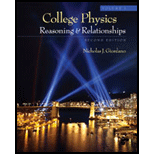
Concept explainers
(a)
An example of motion in which the magnitude of the instantaneous velocity is always larger than the average velocity.
(a)
Answer to Problem 1Q
Circular motion is an example of motion in which the magnitude of the instantaneous velocity is always larger than the average velocity.
Explanation of Solution
Instantaneous velocity is the rate of change of position with respect to time. Whereas the average velocity is the displacement divided by the corresponding time. When an object performs a circular motion, the instantaneous velocity is always greater than the average velocity. This is because the average velocity over any complete cycle is zero since the displacement is zero. But instantaneous velocity assumes some finite value at any given time.
It is obeyed for any object which is accelerating continuously in the direction of velocity.
Conclusion:
Therefore, Circular motion is an example of motion in which the magnitude of the instantaneous velocity is always larger than the average velocity.
(b)
Example of motion having instantaneous velocity is never parallel to the instantaneous acceleration.
(b)
Answer to Problem 1Q
In uniform circular motion, the instantaneous velocity is always perpendicular to the instantaneous acceleration.
Explanation of Solution
During uniform circular motion, the object is moving with constant speed, as the object moves in a circle the change in direction is also conatnt.it is an example of motion having instantaneous velocity is never parallel to the instantaneous acceleration.
Conclusion:
Therefore, in uniform circular motion, the instantaneous velocity is always perpendicular to the instantaneous acceleration.
Want to see more full solutions like this?
Chapter 5 Solutions
College Physics, Volume 1
- A capacitor with a capacitance of C = 5.95×10−5 F is charged by connecting it to a 12.5 −V battery. The capacitor is then disconnected from the battery and connected across an inductor with an inductance of L = 1.55 H . At the time 2.35×10−2 s after the connection to the inductor is made, what is the current in the inductor? At that time, how much electrical energy is stored in the inductor?arrow_forwardCan someone help me with this question. Thanks.arrow_forwardCan someone help me with this question. Thanks.arrow_forward
 Principles of Physics: A Calculus-Based TextPhysicsISBN:9781133104261Author:Raymond A. Serway, John W. JewettPublisher:Cengage Learning
Principles of Physics: A Calculus-Based TextPhysicsISBN:9781133104261Author:Raymond A. Serway, John W. JewettPublisher:Cengage Learning Glencoe Physics: Principles and Problems, Student...PhysicsISBN:9780078807213Author:Paul W. ZitzewitzPublisher:Glencoe/McGraw-Hill
Glencoe Physics: Principles and Problems, Student...PhysicsISBN:9780078807213Author:Paul W. ZitzewitzPublisher:Glencoe/McGraw-Hill An Introduction to Physical SciencePhysicsISBN:9781305079137Author:James Shipman, Jerry D. Wilson, Charles A. Higgins, Omar TorresPublisher:Cengage Learning
An Introduction to Physical SciencePhysicsISBN:9781305079137Author:James Shipman, Jerry D. Wilson, Charles A. Higgins, Omar TorresPublisher:Cengage Learning University Physics Volume 1PhysicsISBN:9781938168277Author:William Moebs, Samuel J. Ling, Jeff SannyPublisher:OpenStax - Rice University
University Physics Volume 1PhysicsISBN:9781938168277Author:William Moebs, Samuel J. Ling, Jeff SannyPublisher:OpenStax - Rice University Classical Dynamics of Particles and SystemsPhysicsISBN:9780534408961Author:Stephen T. Thornton, Jerry B. MarionPublisher:Cengage Learning
Classical Dynamics of Particles and SystemsPhysicsISBN:9780534408961Author:Stephen T. Thornton, Jerry B. MarionPublisher:Cengage Learning Physics for Scientists and Engineers, Technology ...PhysicsISBN:9781305116399Author:Raymond A. Serway, John W. JewettPublisher:Cengage Learning
Physics for Scientists and Engineers, Technology ...PhysicsISBN:9781305116399Author:Raymond A. Serway, John W. JewettPublisher:Cengage Learning





